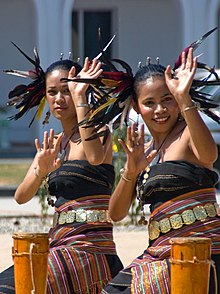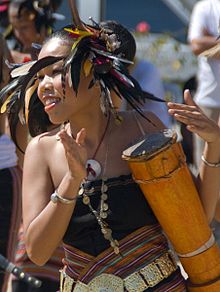
The tambourine is a musical instrument in the percussion family consisting of a frame, often of wood or plastic, with pairs of small metal jingles, called "zills". Classically the term tambourine denotes an instrument with a drumhead, though some variants may not have a head. Tambourines are often used with regular percussion sets. They can be mounted, for example on a stand as part of a drum kit, or they can be held in the hand and played by tapping, hitting, or shaking the instrument.

East Timor, officially the Democratic Republic of Timor-Leste, is a country in Southeast Asia and Oceania. The country comprises the eastern half of the island of Timor and the nearby islands of Atauro and Jaco. The first inhabitants are thought to be descendant of Australoid and Melanesian peoples. The Portuguese began to trade with Timor by the early 16th century and colonised it throughout the mid-century. Skirmishing with the Dutch in the region eventually resulted in an 1859 treaty for which Portugal ceded the western half of the island. Imperial Japan occupied East Timor during World War II, but Portugal resumed colonial authority after the Japanese surrender.

Music of Malaysia is the generic term for music that has been created in various genres in Malaysia. A great variety of genres in Malaysian music reflects the specific cultural groups within multiethnic Malaysian society: Malay, Chinese, Indian, Dayak, Kadazan-Dusun, Bajau, Orang Asli, Melanau, Kristang and others.

The music of Cyprus includes a variety of traditional, Western classical and Western popular genres. Cypriot traditional music is similar to the traditional music of Greece with Turkish and Arab influences, and includes dances like sousta, syrtos, ballos, tatsia, antikristos, arabiye, karotseris, sinalik, chiftetteli, zeimbekiko and the mandra dance.
The culture of East Timor reflects numerous cultural influences, including Portuguese, Roman Catholic, and Malay, on the indigenous Austronesian cultures in East Timor.

Portuguese music includes many different styles and genres, as a result of its history. These can be broadly divided into classical music, traditional/folk music and popular music and all of them have produced internationally successful acts, with the country seeing a recent expansion in musical styles, especially in popular music.

The national flag of East Timor is one of the official symbols of East Timor. It consists of a red field with the black isosceles triangle based on the hoist-side bearing a white five-pointed star in the center superimposed on the larger yellow triangle, also based on the hoist-side, that extends to the center of the flag.

The Bihu dance is an indigenous folk dance from the Indian state of Assam related to the Bihu festival and an important part of Assamese culture. Performed in a group, the Bihu dancers are usually young men and women, and the dancing style is characterized by brisk steps and rapid hand movements. The traditional costume of dancers is centered around the red color theme, signifying joy and vigour.
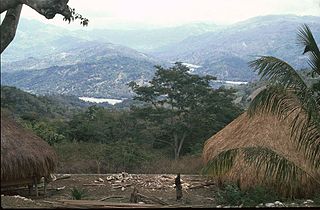
Bobonaro is a municipality in the Democratic Republic of Timor-Leste commonly known as East Timor. It is the second-most western municipality on the east half of the island. It has a population of 92,045 and an area of 1,376 km2.
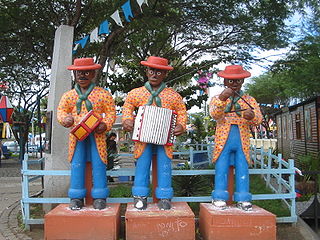
The term forró refers to a musical genre, a rhythm, a dance and the event itself where forró music is played and danced. Forró is an important part of the culture of the Northeastern Region of Brazil. It encompasses various dance types as well as a number of different musical genres. Their music genres and dances have gained widespread popularity in all regions of Brazil, especially during the Brazilian June Festivals. Forró has also become increasingly popular all over the world, with a well-established forró scene in Europe.

The People's Party of Timor is a conservative political party in East Timor. Its predecessor was the Movimento do Povo de Timor-Leste MPTL. The PPT is described as a conservative, backward-looking traditional party with utopian ideas and monarchist and religious tendencies.

Tais is a form of Tenun weaving tradition native to the eastern Indonesian regions of the Maluku Islands, the Tanimbar Islands, and the East Nusa Tenggara Islands. It has become an essential part of people in the eastern Indonesia hemisphere region, which mainly used for ceremonial adornment, sign of respect and appreciation towards guests, friends, relatives, home decor, and personal apparel.
The Culture of Basilan are derived from the three main cultural ethnolinguistic nations, the Yakan, Suluanon Tausug and the Zamboangueño in the southern Philippines. Both Yakans and Tausugs are predominantly Muslim, joined by their kin from the Sama, Badjao, Maranao, and other Muslim ethnolinguistic groups of Mindanao, while the Zamboangueños are primarily Christian, joined by the predominantly Christian ethnolinguistic groups; the Cebuano, Ilocano, Tagalog and others. These three main groups, however, represent Basilan's tri-people or tri-ethnic group community.

East Timor, also known as Timor-Leste, officially the Democratic Republic of Timor-Leste, is a country in Southeast Asia. It comprises the eastern half of the island of Timor, the exclave of Oecusse on the island's north-western half, and the minor islands of Atauro and Jaco. The western half of the island of Timor is administered by Indonesia. Australia is the country's southern neighbour, separated by the Timor Sea. The country's size is 14,950 square kilometres (5,770 sq mi). Dili, on the north coast of Timor, is its capital and largest city.

Gotipua is a traditional dance form in the state of Odisha, India, and the precursor of Odissi classical dance. It has been performed in Orissa for centuries by young boys, who dress as women to praise Jagannath and Krishna. The dance is executed by a group of boys who perform acrobatic figures inspired by the life of Radha and Krishna. The boys begin to learn the dance at an early age until adolescence, when their androgynous appearance changes. In the Odia language, Gotipua means "single boy" (goti-pua). Raghurajpur, Odisha is a historic village known for its Gotipua dance troupes. The dance of the Gotipuas is accompanied by traditional Odissi music with the primary percussion being the Mardala.
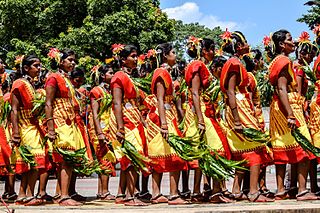
Karma dance or Karma Naach is a traditional dance of central and Eastern India annually performed during the karma festival. Karma is a famous autumnal festival, it starts from the 11th day of the bright fortnight of the month of Bhadrab. It is performed in State of Chhattisgarh, Jharkhand, Madhya Pradesh, Odisha and West Bengal. Karma means 'fate'.
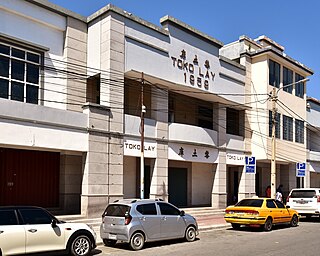
Toko Lay is a commercial building in the centre of Dili, East Timor.

Some of this article is translated from the existing German Wikipedia article at de:Kaibauk; see its history for attribution.

Timorese wedding traditions apply to marriages on the island of Timor, which is divided between Indonesia and East Timor. The wedding traditions are still followed in about half of all marriages in East Timor. Ever since colonial times, there has been heated debate about the value of these traditions and the role of women in them.
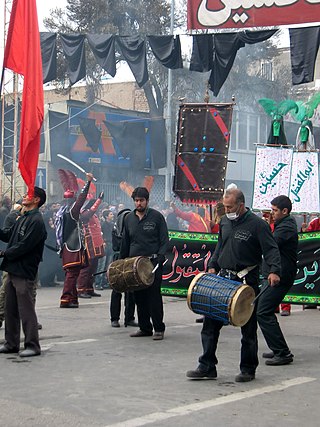
The Dammam is a large double-headed cylinder drum or frame drum played by Shias in Iraq and Iran in religious ceremonies. The dammām is usually struck with the left hand and a curved stick in the right hand, especially during passion plays in the mourning month of Muharram or to wake up the devotees early in the morning of Ramadan.

